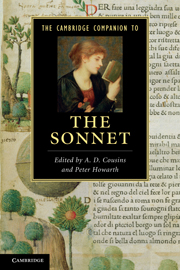Book contents
- Frontmatter
- Introduction
- 1 Contemporary poets and the sonnet
- 2 The sonnet and the lyric mode
- 3 The sonnet, subjectivity and gender
- 4 The English sonnet in manuscript, print and mass media
- 5 European beginnings and transmissions
- 6 Desire, discontent, parody
- 7 Shakespeare’s Sonnets
- 8 Sacred desire, forms of belief
- 9 Survival and change: the sonnet from Milton to the Romantics
- 10 The Romantic sonnet
- 11 The Victorian sonnet
- 12 The modern sonnet
- 13 The contemporary sonnet
- Further reading
- Index
3 - The sonnet, subjectivity and gender
Published online by Cambridge University Press: 28 May 2011
- Frontmatter
- Introduction
- 1 Contemporary poets and the sonnet
- 2 The sonnet and the lyric mode
- 3 The sonnet, subjectivity and gender
- 4 The English sonnet in manuscript, print and mass media
- 5 European beginnings and transmissions
- 6 Desire, discontent, parody
- 7 Shakespeare’s Sonnets
- 8 Sacred desire, forms of belief
- 9 Survival and change: the sonnet from Milton to the Romantics
- 10 The Romantic sonnet
- 11 The Victorian sonnet
- 12 The modern sonnet
- 13 The contemporary sonnet
- Further reading
- Index
Summary
The sonnet is a little poem with a big heart – and at its core lie subjectivity and gender. Both words are grammatically basic yet surprisingly slippery. Although people usually think they know what gender means, subjectivity is a more specialized term, a word that puns on the tensions it captures: whether or not one is familiar with the subject–object split (a basic philosophical problem associated with epistemology since Descartes), the essence of the matter is that the subject of a sentence is also ‘subjected’ to forces beyond itself. Moreover, the human grammatical subject, the self that is supposed to be ‘one’, also knows itself to be multiple and unruly – if ‘one’ is inclined to a modicum of introspection, as poets are wont to be. What does it mean poetically, then, to express one’s own subjectivity, to speak (metaphorically) in one’s own voice?
The sonnet form originated in an age when poets were also political ‘subjects’ to princes, when emotions were perceived as external forces pressuring internal spirits and when earthly experience was deemed subject to heavenly will; the sonnet allowed poets a fourteen-line space in which they could at least articulate, if not exert, their own wills. As Europeans in a hierarchical world that presumed male superiority even if exceptional virgins were subjects of veneration, writers of the first love sonnets expressed the cultural and social paradoxes their desires engendered, as well as their personal experiences of emotional contradiction. Out of this maelstrom arose the split personalities that would become models of great art, and the richly expressive vocabularies that would allow centuries of poetic followers – including women and non-Europeans – to make the sonnet their own, adapting it to capture vastly different perspectives, needs, values and definitions of selves.
- Type
- Chapter
- Information
- The Cambridge Companion to the Sonnet , pp. 46 - 65Publisher: Cambridge University PressPrint publication year: 2011



